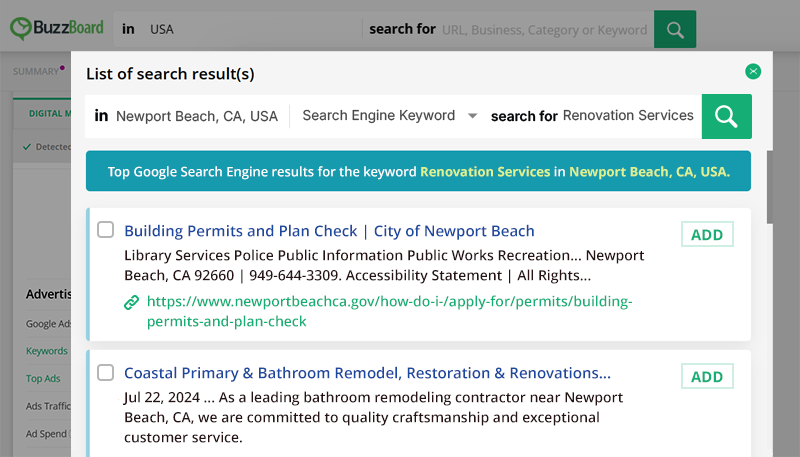Summary
Knowing who your clients are up against is essential for creating effective, tailored marketing proposals and strategies, yet finding the most relevant competitors for your small businesses clients is often challenging. By pinpointing the most relevant competitors—those actively engaging the same local audience with comparable digital maturity—agencies can refine client strategies and position themselves as valuable, data-backed partners to win follow-up meetings.
- Tools and techniques to surface direct, best-matched competitors, eliminating irrelevant or distant players.
- Why evaluating competitors’ digital engagement levels helps to identify key rivals.
- Effective competitive analysis starts with identifying the most relevant competitors—those that matter most to your client and compete directly for their target audience.
Why Identify Competitors for Your Small Business Clients?
If your client is opening a restaurant, they’re not just arranging tables; they’re entering a fiercely competitive market where local eateries are all vying for the same customers’ attention.
For any business today, even the most unique concepts, have competitors just a block away, ready to capture customers at the slightest misstep. As marketing agencies serving these local businesses, identifying and understanding the local competitors is an essential part of building a winning strategy. By closely analyzing who your clients are up against and how those rivals operate, you gain powerful insights that go beyond simply filling seats. You can position your clients more strategically, identify unique strengths, and proactively address potential threats, keeping their brand one step ahead.
For your agency, a thorough grasp of the client’s competition does more than inform proposed strategy, it strengthens your ability to sell. It allows you to highlight concrete, data-backed strategies that stand apart from generic marketing approaches, making your agency’s services more compelling to businesses. A comprehensive competitive analysis means turning insight into impact, driving results for clients, and positioning your agency as an indispensable partner in their success journey.
“I’ve been looking at some of your competitors and it’d be great for you to see how they’re able to grow market share through digital marketing efforts.”, is more likely to get you a follow up meeting with your prospects.
Are you ready to help your clients not just survive but thrive? Now is the time to harness the power of competitive data and transform their marketing strategies for measurable success.
Here are 5 reasons why it is important to know your client’s competitors
Step-by-Step Guide on Identifying Competitors for Small Business Clients
As marketing consultants serving small and local businesses, it’s imperative to understand the intricacies of your market. Competitive analysis for local businesses isn’t just about the competitor on the next street. Your competition could be an e-commerce behemoth.
Executing a competitive analysis for a local business can be streamlined into a simple guide.
Initially, define your client’s market. Distinguish what industry or sector they’re in, specify the target audience’s age, location, buying habits, etc.), and focus on your client’s unique value proposition (UVP).
Next, identify the competitors. They could be businesses in similar categories or those selling alike products or services. Usually, leveraging local directories and online review platforms like Yelp or Google Reviews provide helps with scoping the market and surfacing similar businesses in the vicinity.
To get to the most head-to-head set of rivals that you should watch on behalf of your clients, start with a SWOT analysis of your client’s business and this initial set of similar businesses.
This analysis aids in understanding where your client’s business stands, the challenges it faces, and how it can exploit opportunities vis a vis the competitive and market landscape.
Furthermore, digital tools such as Google Analytics and Facebook Insights can overlay information like demographic statistics, customer behavior insights, etc., to help with the SWOT analysis. Take that a step further with a competitive SEO analysis. Utilities like Moz, SEMRush, or Ubersuggest can offer vital knowledge about these businesses’ search engine keyword strategy, backlinks profile, and more. Investigating their website and social channels paints a more vivid picture on how invested they are in various stages of marketing and growth.
How Do You Find the Right Competitors for Your Small Business Clients
A successful competitive analysis starts with identifying the most relevant competitors that are a strategic match, or your clients care about the most, or the most important kinds, the ones that are raking your clients’ audience away!
What if there was a much more effective, foolproof, and faster way to identify competitors and ?
Time for a reality check—while every seller wants real insights into their client’s market, they often wind up using online directories and general tools that mix relevant competitors with unrelated or indirect ones. Furthermore, once arriving at the best competitors to compare and contrast your client’s marketing standing and strategies, they need to actually undertake the arduous task of compiling this competitive comparison in a meaningful way. This can dilute your valuable insights and lead to ineffective competitive strategies.
Unlike online directories that throw everything (and everyone) at you, direct and comparable competitors are the true benchmarks. They target the same customers, with similar products, using similar strategies, making them your best reference for strategies that move the needle.
How does BuzzBoard make competitor identification a breeze?
BuzzBoard Ignite assists agencies by enabling efficient and best-matched competitor analysis for their clients. BuzzBoard already has its own matching algorithm to surface competitors based on physical proximity to your client’s business, its service offerings, business operations, and digital maturity. Taking it a step further, its exciting new feature update now allows users to identify competitors by leveraging Google’s organic search results (SERP). With this advanced feature, you can specify search criteria, such as location, keywords, or business categories, to find relevant competitors directly inside the BuzzBoard Ignite’s environment. After reviewing the search results, users can decide on the competitors to review and compare against using BuzzBoard’s powerful profile building and further analysis capabilities.

Why Use Google Organic Search Results to Build Your Client’s Competitors List
Google search results give you a real-time snapshot of local competitors who are actively fighting for the same customers in the same geographic market. Unlike other competitor sources such as directories, review sites, and other paid tools that can quickly become outdated, Google’s organic search reflects competitors who are currently optimizing their visibility for local customers. This immediate view reflects the true landscape of who local customers are likely seeing and considering.
This means you’re not just identifying competitors, you’re spotting the players who are currently making waves, launching seasonal promotions, or using local SEO tactics to get in front of your audience. By tapping into this live view of the competition, you can craft sharper, more locally relevant strategies that help your clients stand out where it matters most.
How to Measure Up Your Client’s Marketing Strategy Against Their Competitors?
The next step is examining their online presence. Critically assess the quality of their website, blog content, e-commerce platform, social media engagement, and other marketing initiatives Recognize what they’re accomplishing successfully and where shortcomings exist. You might notice, for example, a robust social media presence undermined by a deficient website.
Subsequently, evaluate their product or service portfolio. What types of products are they offering? How well do they fulfill customer needs?
The final step involves reviewing their customer testimonials and feedback. Gleaning such insights can reveal their strengths and weaknesses from a consumer’s viewpoint.
A detailed analysis like this gives a lucid snapshot of the local business market and shapes how you can deliver exclusive value to your small business clients. It equips you with the ability to propose more targeted marketing strategies built on verifiable data and trends.
Always remember that knowledge of your market and competitors is influential. Harness it to differentiate your clients, ensuring their and by extension your success.
How a Competitive Analysis Can Influence the Growth of a Small Business?
A solid competitive analysis is a growth catalyst for small businesses, revealing not only who else is in the market but also where your client can excel. As a digital consultant, incorporating competitive insights helps clients understand their unique market positioning, enabling them to capitalize on competitor weaknesses and unmet customer needs. And by presenting this data, your agency can demonstrate how strategic adjustments—like targeted messaging, keyword optimization, pricing shifts, or new campaigns—can help clients stand out.
And finally, competition works to convert the ‘uncommitted’, too! There are those prospects that say all the right things, they give you all the buying signals. They even verbally agree with your proposals. But they won’t sign. These are the prospects that just do not like to say “no”. Competition analysis can take you over the goal line with these types of prospects as well.








